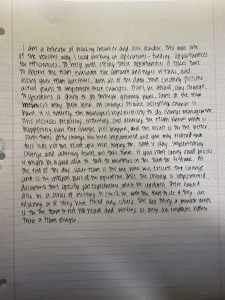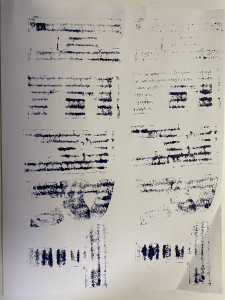 Part 1: Reflection after handwriting a piece
Part 1: Reflection after handwriting a piece
Can you read my handwriting? I was very self-conscious as I was printing because I knew I had to post this on the internet. My printing did not use to look like this. This handwriting task was one of the most challenging tasks I’ve done in a long period of time. I haven’t had to handwrite a paragraph or an essay in over 15 years. Ever since university, my assignments required me to type. Because I haven’t used the muscles in my hand for printing in a while, my hands were tired after every three to four lines. Because of the frequent breaks, my thought process was interrupted many times. It took me longer to handwrite this passage than to type this passage. As Lamb and McCormick said in their podcast, memory changes, so from my initial vision of my passage to the final product, I’m sure that the intention and meaning of my passage have changed (2020). I should have mentioned several points because I lost my train of thought, and the page would look messy if I added lines and arrows indicating what I would like to include. From a young age, I knew I had many spelling mistakes, and my letters were not uniform, so since university, I started buying erasable pens. This allowed me to correct my errors even when writing in pen.
The most significant advantage of typing compared to printing is the ease of editing words and rearranging sentences. I can type what comes to mind first and have the opportunity to revise the piece repeatedly without wasting paper or writing editing notes all over the page. When you read a typed-up article, you won’t know the number of times I’ve rewritten, rearranged, and deleted words. I would type a piece rather than handwrite an essay for the above advantages. On the other hand, I would handwrite a mind map or draw out a flow chart because that process is supposed to be messy, and I can write down ideas in any fashion I want. I know that tablets have this function, but at work, we don’t have the luxury of using a tablet to draw mind maps and flow charts digitally.
 Part 2: Reflection after potato printing
Part 2: Reflection after potato printing
For this portion, I chose to use cardboard to create my stamps instead because I readily have cardboard available from work. I thought Cardboard stamps would have relatively the same effect as potato stamps. I outlined and cut the stamps in about 10 minutes. As you can see, the results did not turn out as I imagined. Although I used the same set of stamps for both prints, the ink was not distributed evenly. I used a brand-new ink pad for this assignment. I think it is because the ink pad was not fully saturated with ink with my first letter. Then as I continued to press each stamp into the inkpad, the cardboard is not evenly distributed with ink. From Cooke’s video, I saw that the ink has to be distributed evenly on each risen part of the stamp for all the words to show up on the page. Imagine a message or the newspaper not printing properly because the stamps are not fully saturated. Readers may have a different understanding or a misunderstanding of the message of what they are reading.
I am so glad to have the luxury of digital keyboards. I cannot imagine putting together the letter stamps to print out this blog post. Paul Collier stated that for letterpressed pieces to be successful, the one setting the stamps together must have a vision of the final product (Cooke, 2012). Because I am not a professional writer or printer, I do not have a final vision of what my piece will look like. I often let my writing take its course, and one of my last steps before the final product is to edit and format the text. Producing a visually pleasing article is an art and has its techniques. Basic computer programs can help me format a document that is visually pleasing to the reader. And it has the function of remembering my last format as a template so my future documents.
References:
Danny Cooke Freelance Filmmaker. (2012, January 26). Upside down, left to right: A letterpress film Links to an external site.[Video]. YouTube.
Lamb, R., & McCormick, J. (Hosts). (2020, May 26). From the vault: Invention of the book, part 1 Links to an external site.[Audio podcast episode]. In Stuff to blow your mind. iHeart Radio.
Angela Heslop
February 22, 2023 — 6:02 pm
Hi Sara! That is quite impressive that you completed both tasks for this week’s assignment – I was under the impression we only needed to complete one, so either you completed double the tasks, or I only completed half!
I felt the same way when completing the handwriting task – I was worried about how it was going to look, as it had to be publicly posted. However, I really enjoy writing by hand, and as you mentioned you needed to continually stop, it actually is good for our brains to have that sense of slowing down, and recalibrating. It was great to read that both tasks gave you a sense of appreciation and gratitude for modern keyboards and typing. It is good to switch between, so our brains can be activated in different arenas.